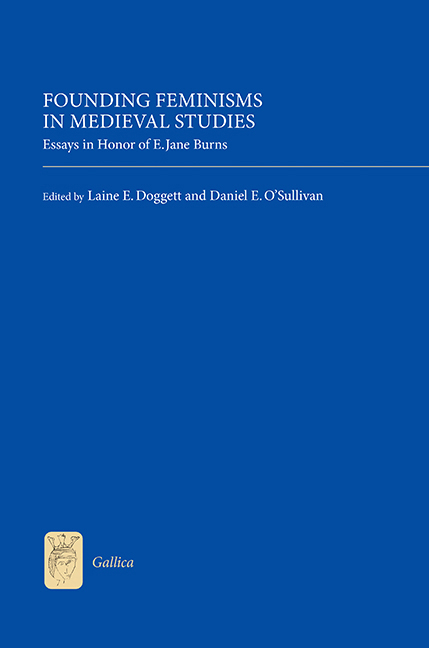Book contents
- Frontmatter
- Contents
- List of Illustrations
- List of Contributors
- Acknowledgements
- Introduction: The Work of E. Jane Burns and the Feminisms of Medieval Studies
- E. Jane Burns: A Bibliography
- Part I Debating Gender
- Part II Sartorial Bodies
- Part III Mapping Margins
- Women's Healing: From Binaries to a Nexus
- Silk in the Age of Marco Polo
- Another Land's End of Literature: Honorat Bovet and the Timbuktu Effect
- Part IV Female Authority: Networks and Influence
- Afterword: A Response to the Volume
- Index
- Tabula Gratulatoria
- Already Published
Silk in the Age of Marco Polo
from Part III - Mapping Margins
Published online by Cambridge University Press: 05 July 2016
- Frontmatter
- Contents
- List of Illustrations
- List of Contributors
- Acknowledgements
- Introduction: The Work of E. Jane Burns and the Feminisms of Medieval Studies
- E. Jane Burns: A Bibliography
- Part I Debating Gender
- Part II Sartorial Bodies
- Part III Mapping Margins
- Women's Healing: From Binaries to a Nexus
- Silk in the Age of Marco Polo
- Another Land's End of Literature: Honorat Bovet and the Timbuktu Effect
- Part IV Female Authority: Networks and Influence
- Afterword: A Response to the Volume
- Index
- Tabula Gratulatoria
- Already Published
Summary
A bolt of silk for each clear toned song. Still these beauties do not think it is enough. Little do they know of a weaving girl, Sitting cold by her window, Endlessly throwing her shuttle to and fro. Ch'ien T'ao, “Written at a Party Where My Lord Gave Away a Thousand Bolts of Silk”
In her 2009 book Sea of Silk, Jane Burns begins her “textile geography of women's work in medieval French literature” with the traditional tale of a Chinese princess who, sent to marry the ruler of the kingdom of Khotan, brings sericulture to Central Asia by smuggling silkworm larvae and mulberry seeds concealed in her head-dress. One of the so-called “Dunhuang tales,” this well-known legend takes its place alongside Procopius's oft-repeated account of the two sixth-century monks who smuggled silkworm eggs out of “Serindia” under the eastern emperor Justinian to explain the westward dissemination of the art of silkmaking. Together, these two tales describe the east-to- west transfer not of intellectual or political power (as in the twinned topoi of translatio studii et imperii cited at the outset of Chrétien de Troyes's Cligés3) but of cultural hegemony, with silk serving as the nexus of diplomacy, commerce, and industrial espionage.
The travels of the thirteenth-century Venetian merchant Marco Polo, in contrast, invert the east-to- west itineraries of the Byzantine monks and the Khotanese bride, tracing a journey from the Latin west to the shores of the Pacific. In 1298, three years after his return to Venice following a twenty-four- year absence, Marco and the Arthurian romance writer Rustichello of Pisa co- authored Le Devisement du monde (The Description of the World), known today as The Travels. Composed in Franco-Italian (a loose name for the dialect of Old French adopted by Italians wishing to write in the vernacular rather than in Latin), the Devisement reflects the dynamism of trans-Asian exchange at the midpoint of the remarkable century chronicled by Janet Abu-Lughod in Before European Hegemony: The World System A.D. 1250–1350, in which the pax mongolica created by the conquests of Genghis Khan and his successors produced a cosmopolitan world of travel, communication, and the circulation of people, goods, and ideas on an unprecedented scale.
- Type
- Chapter
- Information
- Founding Feminisms in Medieval StudiesEssays in Honor of E. Jane Burns, pp. 141 - 152Publisher: Boydell & BrewerPrint publication year: 2016

